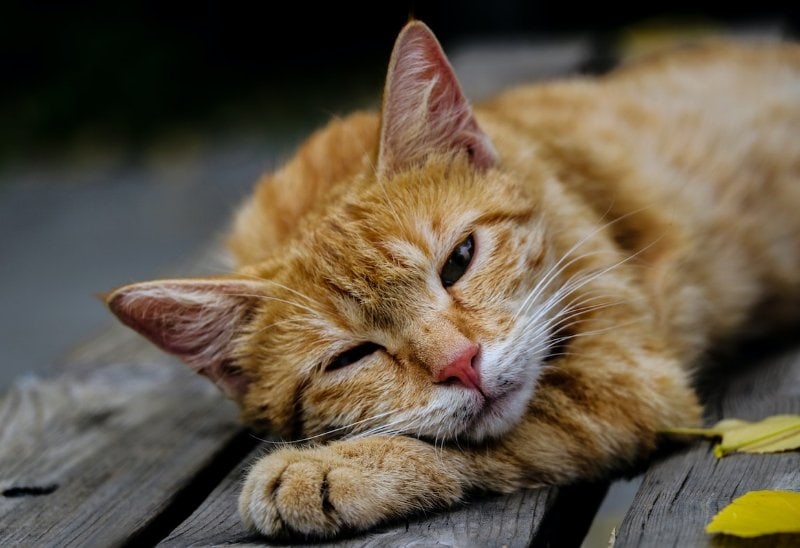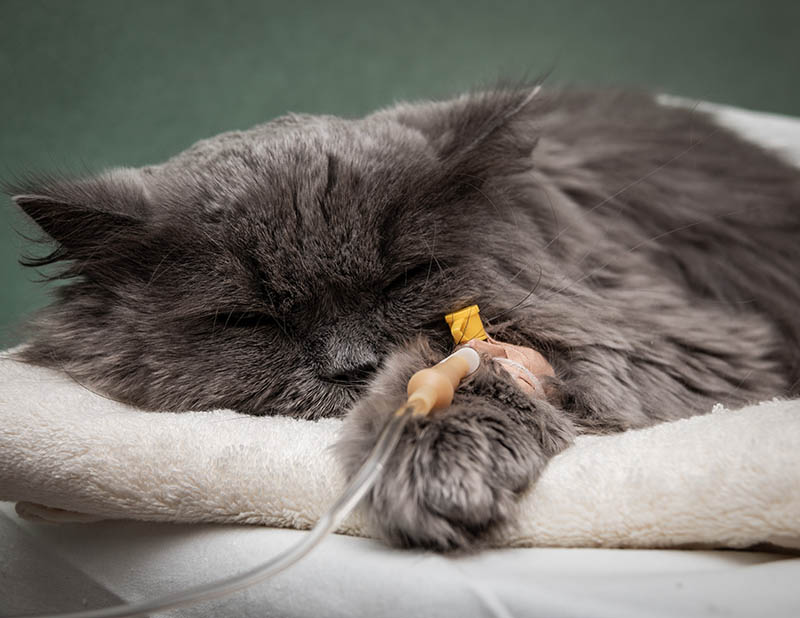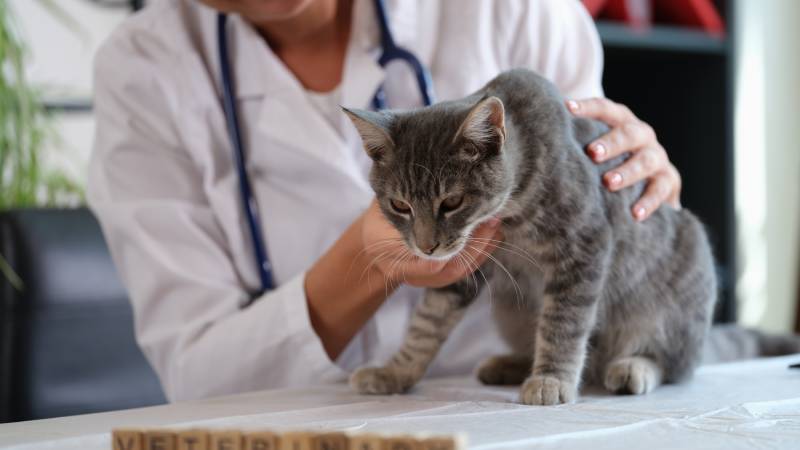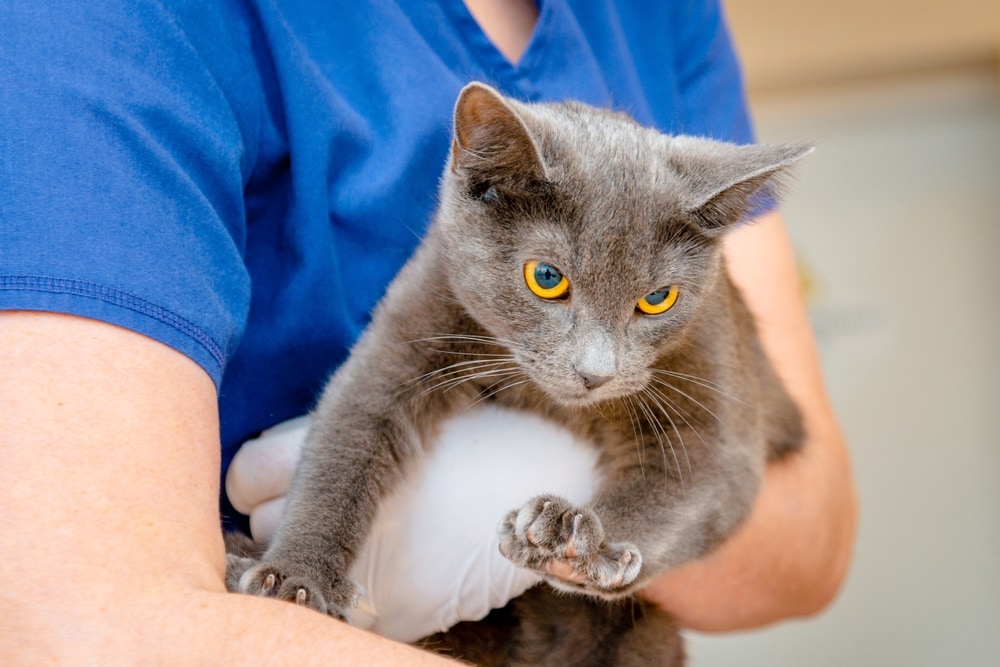
Click to Skip Ahead
Kidney stones are not a very common condition in cats. It’s much more common to find stones that have formed within the bladder. Therefore, the condition may go undiagnosed until the clinical signs are significant and your cat has become very ill. Cats are born with two kidneys, and if one develops stone(s), the unaffected kidney may compensate. This will cause your cat to act completely fine for a long period of time. So, what are the signs of kidney stones in your cat? Continue reading to find out more about them, what can cause them, and how to care for your cat if they have them.
What Are Kidney Stones?
Each cat, except in instances of a rare congenital issue, have two kidneys when they are born. Kidneys develop on each side of the abdomen, and each attach to the bladder with their respective ureters. The bladder then holds the urine and it exits the body out of the urethra. The job of the kidneys is to filter blood, waste, and toxins from the body. These will go into the urine and then be able to safely exit the body. The kidneys work together with other organs to filter waste products and safely eliminate them from the body.
Kidney stones are collections of mineral deposits that can form within the kidneys. At first, the stones resemble small crystals or even aggregates of sand. As the minerals continue to build, and the body’s mineral threshold exceeds the threshold within the kidney, the stones form. Sometimes just one kidney is affected, while other times both kidneys may develop stones. Depending on the type of minerals involved, different types of stones can form. In cats, kidney stones, while rare, are almost always composed of calcium oxalate.

What Are the Signs of Kidney Stones?
As mentioned above, most cats are born with two kidneys. Therefore, if only one kidney develops stones, the other kidney is able to pick up the slack and your cat will feel and act totally fine. You may notice nothing different about how your cat is acting, eating, how much they are drinking and/or urinating.
If the stones in the affected kidney continue to grow larger, eventually obstructing that kidneys’ ability to appropriately drain urine into the bladder, that’s when your cat will get sick. If that kidney is unable to drain urine into the bladder, the kidney will become extremely large. This will be a very painful condition for your cat. This is often accompanied by nausea, vomiting, anorexia, and sometimes a distended abdomen. Obstruction from a kidney stone can occur if the stone is still within the kidney itself, or, it passes into the ureter and then becomes stuck before it makes it down to the bladder. Essentially the urine backs up into the affected kidney instead of safely making it into the bladder and then out of the body.
If your cat is unlucky enough to have both kidneys form stones, you may notice the same abnormal signs as above. The signs may present themselves sooner than if only one kidney is affected because the other kidney is not able to compensate. If neither kidney is able to appropriately drain urine into the bladder, and the body is unable to eliminate the urine, the waste and toxins will continue to build up in your cats’ body. If the body is unable to eliminate this urine, eventually your cat will go into kidney failure and/or pass away.

What Are the Causes of Kidney Stones?
In cats, the most common composition of kidney stones is calcium oxalate. These occur when the levels of calcium oxalate in the body exceed the threshold your cat’s kidney is able to filter and eliminate. Over time, these minerals build up, increasing in size until a stone is formed.
Currently, no one thing has been found to be the cause of kidney stones. Because this condition is rare in cats, most studies are focused on the formation of bladder stones in cats. There has been correlation found to inactive house cats with low fluid intake. In other words, cats who only eat dry kibble and/or do not take in enough water during the day may be more prone to developing kidney stones. There have been no clear links found to certain brands of kibble and/or brands of food, just a compelling connection to decreased water intake.
How Do I Care for a Cat With Kidney Stones?
Caring for a cat with kidney stones varies depending on when the diagnosis is made. If your cat is still eating, drinking, and acting normal, and there is no current obstruction, increasing fluid intake is the first step. You will want to try and put your cat on canned food, or at least a kibble with a higher water content. This will help the kidneys to be flushed out more frequently, removing small amounts of mineral and waste build-up.
You can also provide more, and lots of, fresh water for your cat around the house. Put out bowls in every room, try a cat water fountain, and even experiment with different types of bowls (e.g., glass, plastic, metal, ceramic) to see what your cat prefers. If your cat loves having a water fountain, add more around the house – just be certain to clean them regularly so mold, mildew, and bacteria do not form. You can even try to add small amounts of tuna juice, salmon juice, or chicken juice to the water to entice your cat to drink more. Never add oils to the water!
If your cat has an obstruction, your veterinarian may recommend hospitalization to try and push the stone(s) into the bladder. Unfortunately, once an obstruction is present, surgery is very rarely performed. If your cat has evidence of kidney disease on bloodwork, your veterinarian may also recommend putting your cat on a prescription kidney diet, or even giving them subcutaneous fluids a few times a week. All of these things depend on if your cat is affected and/or feeling sick from the kidney stones or not.
Your veterinarian will likely want to monitor regular bloodwork (to monitor the function of the kidneys), urine samples (to monitor for infections and crystals), and radiographs (to monitor for the development of more stones).

Frequently Asked Questions (FAQs)
How Can My Veterinarian Diagnose Kidney Stones?
Most routine radiographs, or X-rays, will show kidney stones. Rarely your cat may develop a type of stone that does not show up on an X-ray, in which case an ultrasound, MRI, or CT may be needed for diagnosis.
In addition to radiographs, a urine sample will be evaluated to look for signs of infection, crystals, blood and/or inflammation. Bloodwork is completed to evaluate the functionality of the kidneys.
Can My Cat Have Surgery to Remove Kidney Stones?
Unfortunately not. This is typically not recommended or performed in cats. If it is, the surgery should be completed by a Board Certified Veterinary Surgeon and would typically not be performed unless the stone was already in the ureter.
In lieu of surgery, if there is an obstruction present, typically your cat will be hospitalized on aggressive IV fluids and given medications to try and increase urine output. Your veterinarian will then monitor your cats’ urine output and if the stone is able to safely move into the bladder. If the stone(s) are able to make it into the bladder, surgery can be more safely performed to remove them.

Are Kidney Stones Fatal?
They can be, but not all the time. If the stones never cause an obstruction, and urine is still able to be normally formed and excreted from the body, your cat will be fine. If the stone is able to pass into the bladder, they can then be more safely removed via surgery. If your cat only has one kidney that is affected, the other kidney is typically able to work for long periods of time without any help.
If your cat has both kidneys forming kidney stones and/or both sides are obstructed, your cat does not have a good prognosis. If your cat is unable to pass urine out of the body, this is a fatal condition.
Conclusion
Although rarer than bladder stones, we can see kidney stones in cats. Cats almost always develop calcium oxalate stones that will begin as small crystals and continue to grow into larger stones. These stones may stay within the kidney, or they may pass into the ureter. If at any time the urine is unable to appropriately pass into the bladder and out of the body, your cat may become very ill and even pass away. Your veterinarian will want to monitor regular bloodwork, urine samples, and X-rays if your cat has been diagnosed with kidney stones. Increasing your cat’s water intake may help to prevent further stone formation and even flush out mineral deposits that are already present.
Featured Image Credit: stokerolga, Shutterstock







